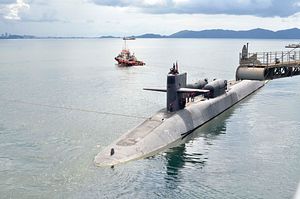This week, Saudi Arabia’s King Salman Abdulaziz Al Saud paid his inaugural trip to Malaysia since ascending to the throne in 2015. As I noted previously, though the agenda was wide-ranging, defense issues, including terrorism, were at the forefront: (See: “Malaysia, Saudi Arabia Step Up Terror Fight”). This was evidenced by Salman’s meeting with Malaysia’s Defense Minister Hishammuddin Hussein as well as his introduction to the chief of defense force and the service chiefs from the army, navy and air force during his visit.
Some of the initiatives discussed fleshed out those already underway, such as joint military exercises and countering radical narratives and ideologies through the establishment of a new center (See: “Why is Malaysia in Saudi-led War Games in the Middle East?”). But there were also some other defense-related items that did not make as many headlines but were nonetheless notable.
The first was the potential sale of military equipment from Saudi Arabia to Malaysia. According to a press release issued by the defense ministry, Riyadh agreed to “give serious consideration” to sell surplus military equipment, particularly fighter jets and helicopters for the Royal Malaysian Air Force and Army Aviation Unit.
On the one hand, one can see the general logic of such an arrangement. As Saudi Arabia upgrades some of its aircraft within its air force, it might be inclined to consider selling older ones, especially since both countries operate some similar platforms and Malaysia has also had some trouble financing its defense needs. But on the other hand, that would also be contingent on key specifics, such as the alignment of this with Malaysia’s already ongoing military modernization efforts as well as the broader challenges associated with acquiring and maintaining older aircraft.
The other interesting point of conversation was submarine training. The Royal Malaysian Navy (RMN) agreed to offer the sharing of expertise as well as joint training to improve the ability of Saudi Arabia’s navy in operating submarines.
That might seem odd as first. Though the RMN has been operating two French-built Scorpene-class submarines along with a submarine training and simulation center, Saudi Arabia currently does not operate any submarines at all (See: “Malaysia Eyes Submarine Base Expansion in the South China Sea”). But the idea here is that as Riyadh moves towards acquiring them as it has been mulling over the past few years, Malaysia can help it get some expertise and training.
Some of the new initiatives might take some time to materialize, especially since the relationship is building from a basic base. In fact, Hishammuddin himself was clear in noting that further details are expected to be discussed by both sides in the coming months. But as he also noted in a piece in the New Straits Times following Salman’s visit, the state of bilateral defense relations have also never been stronger and there have been several milestones reached. In that vein, it will be interesting to see what kind of progress Malaysia and Saudi Arabia can make in their defense relationship over the next few years building on the recent momentum.
































